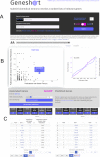Geneshot: search engine for ranking genes from arbitrary text queries
- PMID: 31114885
- PMCID: PMC6602493
- DOI: 10.1093/nar/gkz393
Geneshot: search engine for ranking genes from arbitrary text queries
Abstract
The frequency by which genes are studied correlates with the prior knowledge accumulated about them. This leads to an imbalance in research attention where some genes are highly investigated while others are ignored. Geneshot is a search engine developed to illuminate this gap and to promote attention to the under-studied genome. Through a simple web interface, Geneshot enables researchers to enter arbitrary search terms, to receive ranked lists of genes relevant to the search terms. Returned ranked gene lists contain genes that were previously published in association with the search terms, as well as genes predicted to be associated with the terms based on data integration from multiple sources. The search results are presented with interactive visualizations. To predict gene function, Geneshot utilizes gene-gene similarity matrices from processed RNA-seq data, or from gene-gene co-occurrence data obtained from multiple sources. In addition, Geneshot can be used to analyze the novelty of gene sets and augment gene sets with additional relevant genes. The Geneshot web-server and API are freely and openly available from https://amp.pharm.mssm.edu/geneshot.
© The Author(s) 2019. Published by Oxford University Press on behalf of Nucleic Acids Research.
Figures



References
-
- Jensen L.J., Saric J., Bork P.. Literature mining for the biologist: from information retrieval to biological discovery. Nat. Rev. Genet. 2006; 7:119–129. - PubMed
-
- Mikolov T., Chen K., Corrado G., Dean J.. Efficient estimation of word representations in vector space. 2013; arXiv doi:16 January 2013, preprint: not peer reviewedhttps://arxiv.org/abs/1301.3781.
Publication types
MeSH terms
Grants and funding
LinkOut - more resources
Full Text Sources
Medical
Molecular Biology Databases
Miscellaneous

